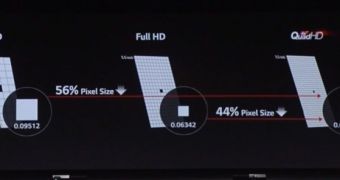Four years after Apple set the benchmark for picture quality on a mobile device, LG is (indirectly) calling Steve Jobs a liar and wants to render Retina displays obsolete. According to a claim made by the Japanese electronics vendor during its G3 smartphone launch, Quad HD is what deserves retina marketing.
When Steve Jobs introduced the iPhone 4 in 2010, he implicitly made our acquaintance with the Retina display marketing term used by the company to define a resolution so fine the human eye could not distinguish individual pixels at a viewing distance of around 12 inches.
According to Jobs, the 300 PPI mark is where the human retina loses its ability to make out one pixel from another. In other words, Jobs claimed to have introduced a flawless viewing experience (resolution-wise) for mobile devices. Well, according to LG, that’s not entirely true. In fact, it’s a lie.
“There’s one common misunderstanding within the smartphone industry. There’s a misconception that the human eye can only distinguish differences in display quality up to around 300 pixels per inch. However, this is not the case,” LG said at its show.
“The human eye can in fact discern differences in display quality above this measure and this is a fact that’s already understood in the printing industry. Today what they consider the best print quality is what LG has achieved with the introduction of its first Quad HD display, as seen in the G3.”
The reality is that picture quality isn’t just in the pixels, but also in the chemicals and the backlighting and everything else that makes up a display.
Calling the Retina standard an industry misconception is probably not entirely fair, considering that 300 individual pixels are indeed indistinguishable 12 inches away from your face. The rest of the story has to do with many other factors.
But sitting at 538 PPI, the G3 screen indeed sets the benchmark for viewing quality on a mobile device today.
“If it were true that the human eye could only discern differences in display quality up to a maximum off 300ppi, then you wouldn’t be able to notice these differences in clarity and sharpness between the images shown,” LG concluded.
Apple’s iPhone 6 coming out later this year is not expected to boost the dots-per-inch count, as customers seem completely satisfied with the pixel density on their iPhones, and especially on their iPads. A few select Macs already employ the standard, and many more will adopt Retina displays in the future as well.

 14 DAY TRIAL //
14 DAY TRIAL //